Phosphorylation of SNAP-23 by the novel kinase SNAK regulates t-SNARE complex assembly
- PMID: 10588641
- PMCID: PMC25741
- DOI: 10.1091/mbc.10.12.4033
Phosphorylation of SNAP-23 by the novel kinase SNAK regulates t-SNARE complex assembly
Abstract
The docking and fusion of cargo-containing vesicles with target membranes of eukaryotic cells is mediated by the interaction of SNARE proteins present on both vesicle and target membranes. In many cases, the target membrane SNARE, or t-SNARE, exists as a complex of syntaxin with a member of the SNAP-25 family of palmitoylated proteins. We have identified a novel human kinase SNAK (SNARE kinase) that specifically phosphorylates the nonneuronal t-SNARE SNAP-23 in vivo. Interestingly, only SNAP-23 that is not assembled into t-SNARE complexes is phosphorylated by SNAK, and phosphorylated SNAP-23 resides exclusively in the cytosol. Coexpression with SNAK significantly enhances the stability of unassembled SNAP-23, and as a consequence, the assembly of newly synthesized SNAP-23 with syntaxin is augmented. These data demonstrate that phosphorylation of SNAP-23 by SNAK enhances the kinetics of t-SNARE assembly in vivo.
Figures

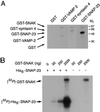
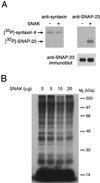
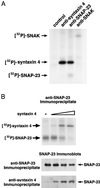

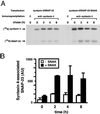

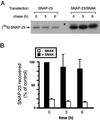
Similar articles
-
Differential phosphorylation of syntaxin and synaptosome-associated protein of 25 kDa (SNAP-25) isoforms.J Neurochem. 1999 Feb;72(2):614-24. doi: 10.1046/j.1471-4159.1999.0720614.x. J Neurochem. 1999. PMID: 9930733
-
SNAP-23 participates in SNARE complex assembly in rat adipose cells.Biochem J. 1999 Mar 15;338 ( Pt 3)(Pt 3):709-15. Biochem J. 1999. PMID: 10051443 Free PMC article.
-
Binary interactions of the SNARE proteins syntaxin-4, SNAP23, and VAMP-2 and their regulation by phosphorylation.Biochemistry. 1998 Aug 4;37(31):11089-96. doi: 10.1021/bi980253t. Biochemistry. 1998. PMID: 9693005
-
SNARE complex regulation by phosphorylation.Cell Biochem Biophys. 2006;45(1):111-23. doi: 10.1385/CBB:45:1:111. Cell Biochem Biophys. 2006. PMID: 16679567 Review.
-
Function of the t-SNARE SNAP-23 and secretory carrier membrane proteins (SCAMPs) in exocytosis in mast cells.Mol Immunol. 2002 Sep;38(16-18):1337-40. doi: 10.1016/s0161-5890(02)00084-6. Mol Immunol. 2002. PMID: 12217404 Review.
Cited by
-
Exocytosis Proteins: Typical and Atypical Mechanisms of Action in Skeletal Muscle.Front Endocrinol (Lausanne). 2022 Jun 14;13:915509. doi: 10.3389/fendo.2022.915509. eCollection 2022. Front Endocrinol (Lausanne). 2022. PMID: 35774142 Free PMC article. Review.
-
A new role for a SNARE protein as a regulator of the Ypt7/Rab-dependent stage of docking.Proc Natl Acad Sci U S A. 2000 Aug 1;97(16):8889-91. doi: 10.1073/pnas.160269997. Proc Natl Acad Sci U S A. 2000. PMID: 10908678 Free PMC article.
-
The nuts and bolts of the platelet release reaction.Platelets. 2017 Mar;28(2):129-137. doi: 10.1080/09537104.2016.1240768. Epub 2016 Nov 16. Platelets. 2017. PMID: 27848265 Free PMC article. Review.
-
t-SNARE dephosphorylation promotes SNARE assembly and exocytosis in yeast.EMBO J. 2001 Feb 1;20(3):411-21. doi: 10.1093/emboj/20.3.411. EMBO J. 2001. PMID: 11157748 Free PMC article.
-
Vimentin filaments in fibroblasts are a reservoir for SNAP23, a component of the membrane fusion machinery.Mol Biol Cell. 2000 Oct;11(10):3485-94. doi: 10.1091/mbc.11.10.3485. Mol Biol Cell. 2000. PMID: 11029050 Free PMC article.
References
-
- Anderson HA, Roche PA. Phosphorylation regulates the delivery of MHC class II invariant chain complexes to antigen processing compartments. J Immunol. 1998;160:4850–4858. - PubMed
-
- Araki S, Tamori Y, Kawanishi M, Shinoda H, Masugi J, Mori H, Niki T, Okazawa H, Kubota T, Kasuga M. Inhibition of the binding of SNAP-23 to syntaxin 4 by Munc18c. Biochem Biophys Res Commun. 1997;234:257–262. - PubMed
-
- Bennett MK, Scheller RH. A molecular description of synaptic vesicle membrane trafficking. Annu Rev Biochem. 1994;63:63–100. - PubMed
-
- Brennwald P, Kearns B, Champion K, Keranen S, Bankaitis V, Novick P. Sec9 is a SNAP-25-like component of a yeast SNARE complex that may be the effector of Sec4 function in exocytosis. Cell. 1994;79:245–258. - PubMed
MeSH terms
Substances
Associated data
- Actions
LinkOut - more resources
Full Text Sources
Molecular Biology Databases

